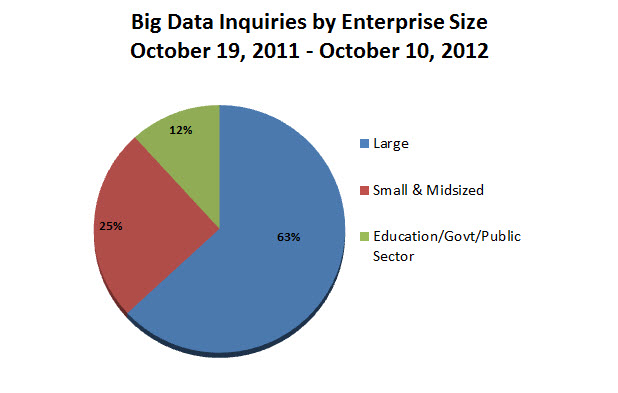Big Data is quickly being catapulted to the top of Marketing’s agenda, but it remains a challenge for many companies in preparing for this shift. According to a survey conducted by IBM, less than half of CMO’s feel prepared to cope with this increasing amount of marketing data over the next 5 years, with the data explosion cited as their #1 headache. The problem isn’t obtaining data, it’s figuring out how to turn it into marketing magic. I’m seeing a growing list of exceptional cases of marketer’s shifting their organizations to adopt a higher level of data-informed decision making, often with astonishing results.
It’s not so much big data, but smart data used at scale
Last week, I had dinner with Joe Rospars, founding partner at Blue State Digital, who served as Obama’s Chief Digital Strategist for his 2008 and 2012 campaigns, and asked him about big data. He responded, their approach “wasn’t so much big data, but smart data used at scale.” To win this election, they needed to get very granular in their targeting. By extracting voter files and collecting information via the tens of thousands of polling calls made to homes every night, they were able to identify by household individual voter likelihood, and then determine the communications they needed to deliver.
The Obama campaign expertly targeted via online advertising, email, door to door and phone canvassing very personalized messaging. They cleverly extended this strategy via social media. Nearly a million supporters that ‘liked’ the Obama 2012 page also allowed access to their profile data via Facebook Connect. This enabled Obama’s people to identify their Facebook friends in battleground States, cross tabulate with their own databases, which they then asked supporters to email or even personally call their friends that fit likely Obama voter profiles, to remind them to register or vote early.
Data is the engine for Adaptive Marketing
Data is allowing brands to move quicker and more decisively to gain a market advantage by dynamically informing their messaging and media.
Samsung a big investor in data, worked with insights firm Networked Insights, to use real-time social listening to help them keep a finger on the pulse of consumer sentiment and adjust their communications to capitalize on the web discussion about brands.
Within a couple of hours of Apple’s Tim Cook revealing their iPhone 5, Samsung reading the reaction in social channels, drafted new print, digital, and TV ads. The following week as the iPhone hit the stores, they aired TV ads mocking Apple customers queuing up for the new phone and some of its less flattering features. The commercial was a hit, and received more than 70 million views online.
They also used social listening as a real time guide to evaluate how effective their ads were with consumers by measuring what people are saying about them and what effect they’ve having on competitors’ brands. Stressing the importance of data in informing their marketing, Brian Wallace, the former VP of Marketing at Samsung, (who recently moved to Motorola to a global marketing role) said, “The data guys lead these conversations. Not the creative guys. Not the sale guys. And it’s not just analytics — it’s analysis.” He added, “[data] does not crush the art of advertising. It simply informs it — and ultimately improves it.” Samsung’s shift to a strategy of employing social data at the center was one of the key factors that assisted them to move from the number 4 mobile device manufacturer to pass the mighty Apple.
Creating a more personalized customer experience
I’m seeing a focus on data enabling marketers to create smarter, more engaged customer experiences.
I recently chaired a panel which included Sandra Zoratti, co-author of the book Precision Marketing. She cited Caesar’s Entertainment as a marketer that centralized data to better formulate its approach to marketing. They identified 0.15% of their customers that contributed to 12% of their casino revenues. This led to them employing Good Luck Ambassadors to monitor these customers. If they weren’t having a good night on the tables, they offered complimentary tickets to a show or dinner based on their known preferences to ensure they left their casinos with a positive experience.
Building a fluid organization that can capitalize on the data
Shifting to a fast moving data marketing organization isn’t just about software and strategy. It requires a shift in how the agency and clients teams work.
The Obama campaign quadrupled their data team from the previous election campaign, adding data technologists, behavioral scientists and mathematicians to crunch the data and help interpret them into actionable marketing insights.
According to Rospars, to improve speed of activation, they established a persona playbook on how the brand should speak, to allow them to delegate decision making down.
Personally, I love this shift to data-informed decision making. It is creating more adaptive, more relevant and more commercial marketing programs. We are barely scratching the surface, but it’s clear that going forward, data will be an enabler of more potent marketing.
Thanks to Brand Media Strategy
![10 Things Your Customers Wish You Knew About Them [Infographic]](https://i0.wp.com/anitaloomba.com/wp-content/uploads/2012/09/10_things_you_should_know_about_your_customers_infographic.jpg?resize=540%2C800)
![10 Things Customers wished you knew about them 10 things you should know about your customers infographic 10 Things Your Customers Wish You Knew About Them [Infographic]](https://i0.wp.com/anitaloomba.com/wp-content/uploads/2012/09/10_things_you_should_know_about_your_customers_infographic.jpg)










